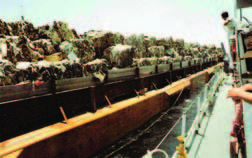Part I Understanding the Problem
What’s so mysterious about recycling? We dutifully put our waste paper, cardboard, empty cans, plastic containers, and glass jars into our recycle containers and then set them at the curb. Some of the more conscientious of us even give some thought to the rules for what can be recycled and how it should be sorted. Others don’t. Then we all go about our daily lives thinking that we are building a more sustainable world by turning our waste into someone else’s treasure. Seems simple enough. Ah, if only that were true.
Historical Perspective
Recycling, as we think of it today, didn’t come into existence until the early 1970’s. Even then, it didn’t really catch the nation’s attention until 1987, when the ill-fated garbage barge named Mobro 4000 sailed from Islip, Long Island, NY. Loaded with 3,100 tons of garbage, and trash, the barge traveled down the east coast, along the Gulf coast to Mexico, and finally to Belize in Central America looking for a landfill that would accept its cargo. No one wanted the Mobro 4000’s garbage, and so it was hauled all the way back to New York, where it was met with a restraining order. A legal battle ensued. Seven months later, the trash was finally incinerated in Brooklyn.

The story was front-page news for weeks and became the wake up call for many communities that we were all in danger of being buried in our own trash.
Recycling efforts
But to really understand our problems with waste we have to go back to a time long before the Mobro 4000 ever left port. The case can be made that the need for modern recycling began on December 7, 1941. World War II forged cataclysmic changes that totally reshaped how the human race interacted with the natural world. Driven by a frantic need to develop weapons capable of destroying life and property on a scale unimaginable by anyone up to this point, the world’s governments reacted quickly. Mankind’s brightest minds combined with unlimited resources were wildly successful in opening a Pandora’s box of technological advancements and high production techniques. These were unlike anything ever seen and whose impacts on the environment were not understood. In fact, their impact was not even considered relevant. “Win at any cost” was the only option.
The war ended, but there was no closing the lid on the box. The war’s chemical and nuclear technologies were quickly redirected into creating plastics, synthetic fibers, fertilizers, pesticides, power plants, and thousands of other products to make our lives more comfortable and enjoyable. Remember that prior to WWII, the American consumer endured 12 years of the Great Depression when thrift, shortages, and making do without were the order of the day.
All these new products, combined with the war’s high-speed production facilities, set the stage for the consumer boom that gave rise to the Fabulous Fifties, the Soaring Sixties, and eventually a barge named Mobro 4000.
This new peacetime economy’s efficiency and productivity brought consumer goods to market in high quantities and at low prices. Americans quickly bought into the idea that disposable goods were the way to a life of ease and plenty. The “throw it out and buy another rather than repair it” mentality, along with a rapidly growing population, proved to be the perfect recipe for creating mountains of garbage.
The Problem
And boy do Americans create a lot of garbage. We are talking about hundreds of millions of tons per year, and the collection, hauling, and

Photo courtesy of Flickr user Slideshow Bruce
disposing of this mountain of began in earnest, and by the year 2000, at least half of all Americans could leave their bottles, cans and newspaper at the curb. Progress continues, and in 2010, Oregonians recovered 50% of their waste, according to the Oregon Department of Environmental Quality. municipal solid waste (as it is now called) presents a formidable challenge. The problem grows each year as shown by the data compiled by The U.S. Environmental Protection agency. In 1960, each one of us threw out 2.68 pounds of waste every day, but by 2010, we were each throwing away 4.43 pounds of waste daily. With our population growth over the same 50-year period, the grand total of waste generated in 2010 was 250 million tons.
As if this huge amount of waste is not enough of a problem in itself, we also have to contend with the fact that the vast majority of what we discard today is composed of materials and chemical compounds that did not exist 60 years ago. Some experts estimate that there are 30,000 to 40,000 chemical compounds that we are exposed to today that did not exist prior to WWII. These materials are not only resistant to being broken down naturally, but their very chemical makeup can wreak havoc with the biological processes of most living creatures that come in contact with them. “Another man’s treasure” in this mess is hard to find.
So the question is: why can’t a nation that put a man on the moon in 10 years, solve its messy garbage problem in 30 years?
Read The Mysteries of Recycling Part II: The Business of Recycling, and Part III: The Future




